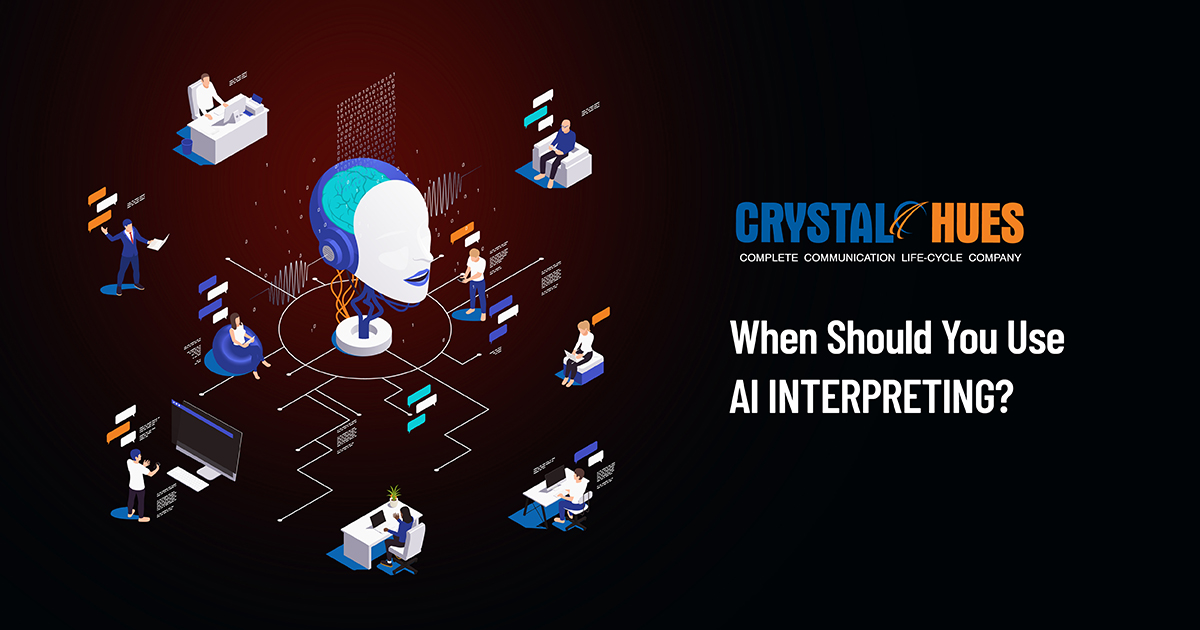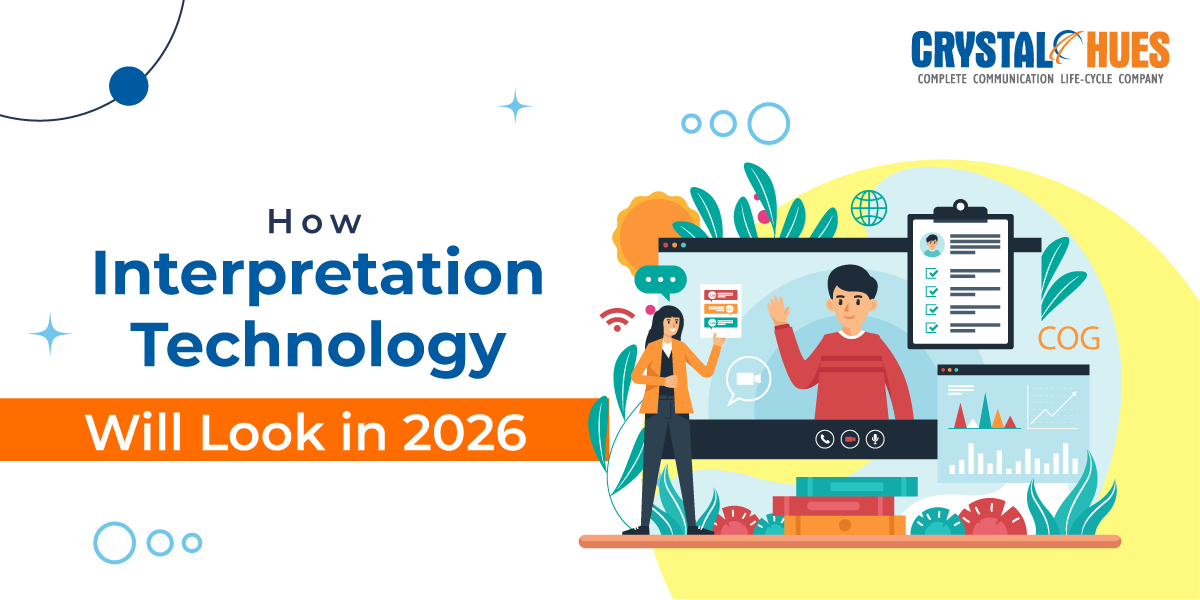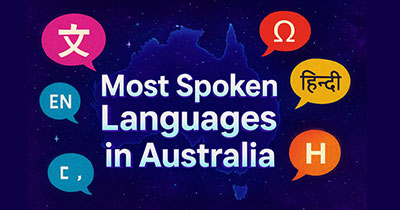
When Should You Use AI Interpreting?
AI interpreting has come a long way from clunky word-for-word translations. But here’s the truth: knowing when to use it (and when not to) can make the difference between smooth communication and costly misunderstandings. Whether you’re running an event, handling client calls, or managing cross-border teams, the right choice can save time, money, and your reputation.
The demand for
effective, speedy, and scalable interpreting solutions has never been greater.
Whether it is international conferences, live customer support, or telehealth
visits, language should never limit communication opportunities.
However, like all
tools, the key question is determining when and in what circumstances to use
it.
AI interpreting has the
unique advantages of speed, cost, and scalability, but it will not be the
appropriate fit in every circumstance.
It’s important for
organizations and individuals that are making strategic communication decisions
to know when AI interpreting is beneficial and when human interpreters are
irreplaceable.
But first, let’s understand what is AI interpreting and how it works.
What is AI Interpreting?
AI interpreting refers
to the process of interpreting spoken language using artificial intelligence,
specifically machine learning algorithms and natural language processing (NLP),
in real-time speech interpretation.
The interpreting
process is delivered using dedicated technologies, mobile applications,
web-based software, integrated technologies (e.g., smart assistants), or
integrated into online meeting platforms (e.g., Microsoft Teams, Zoom).
Unlike traditional
machine translation (text to text), or text-to-speech applications that would
also be considered a form of AI interpreting, the AI interpreting process
involves the processing of spoken language, the transcription of spoken
language, the translation of spoken language, and the output of spoken
translated content, all in seconds.
Best Use Cases for AI Interpreting
1. Routine and
Repeated Situations
AI interpreting does
well not only in structured and predictable environments, and with a limited
choice of vocabulary, but also when the modality is repetitive, formulaic, and
not very nuanced.
For example, guided
tours, airport announcements, and instructions in warehouses. The language in
those contexts is easier for AI models to reasonably predict because they use
much of the same common language and structural phrasing.
Use case examples:
- Tourist assistance kiosks at airports
- Pre-recorded public service announcements
- Automated check-in and check-out in hospitality
2. Time-Sensitive
Situations
AI interpreting enables
an immediate response when there is limited or no access to a human
interpreter. While not perfect, AI interpreting can provide a bridge and
produce some level of mutual understanding.
Use case examples:
- Emergency response interactions
- Ad hoc interpreting scenarios for virtual
meetings
- Crisis support in multiple languages during
natural disasters
3. Low-Stakes
Conversations
AI can be helpful in
informal or low-risk environments. Users may be less concerned about the
absence of linguistic perfection and would prioritize convenience over complete
accuracy.
Use case examples:
- Travelers in leisure and adventure scenarios
- Internal communication situations (e.g.:
multilingual teams)
- Customer support triage for global products
4. Scalability and
Cost Savings
If you’re operating
across multiple markets, especially with high volumes of multilingual content,
AI interpreting offers readily scalable solutions because you won’t have to
book interpreters for each conversation. It could also significantly reduce your
costs and the effort of finding an interpreter depending on each situation.
Further, it could be added directly into customer experience pipelines or
operational workflows.
Some use cases:
- AI chat or voice support across geographies
- Interpreting support in webinars or online
learning platforms
- Onboarding sessions for large global workforces
5. Basic
Accessibility
AI interpreting also
provides additional accessibility. For example, when translated subtitles are
shown in real time during a live video event, non-native speakers have greater
accessibility, which can be especially empowering in educational or workplace
contexts.
However, just because AI interpreting can handle some tasks,
doesn’t mean it’s right for every situation. Sometimes you need to think twice.
Limitations of AI Interpreting
Although AI
interpreting technologies are rapidly advancing, it is still fundamentally
limited, specifically when it comes to human communication, which is inherently
much more complex. There are situations in which using AI interpreting could
create misunderstandings, inadvertently cause offense, and expose you to legal
liability.
1. High-Stakes
Situations or Sensitive Contexts
Nuance, tone, and
cultural sensitivities are of utmost importance in most interactions. In
legal, diplomatic, or medical contexts, the significance of a relatively
harmless misinterpretation could be catastrophic.
Human interpreters not
only recognize language, but also cultural underpinnings, tone, and emotion,
all of which remain an area of difficulty for AI.
Red flags in use cases:
- Legal depositions or court scenarios
- Mental health consultations
- High-level diplomatic environments
2. Contextually
Sensitive Cultural Communication
When it comes to
translating content created in major world languages, AI systems are a step
ahead. However, the nuances of idioms, jokes, and culturally-specific
references can be very difficult for AI to figure out.
Humans can mediate and
help build the context for interpretation as they are interpreting in real
time, something no algorithm can do. Human interpretation remains the gold
standard in cases where cultural preservation and accuracy are critical to the
community.
3. Low-Resource
Languages
Although major world
languages are increasingly well served by AI models, very low-resource or
endangered languages typically do not have adequate training data to produce
usable AI interpretation. Community interpreters are an especially important
resource when little technology exists.
4. Accents and
Quality of Audio
Many AI systems fail to
handle things like background noise, multiple speakers, or strong regional
accents, all of which can significantly affect accuracy. In complex live
contexts, humans demonstrate greater flexibility and can use topical cues,
which may fill what would be considered gaps or misinterpretations by an AI
system.
The Hybrid Model:
AI + Human Interpreting
One of the most
exhilarating developments in the interpreting space is hybrid, which utilizes
AI to augment human interpreters instead of eliminating them. AI takes care of
the straight forward or repetitive parts of the dialogue, and humans intervene for quality assurance, complicated conversations, and nuanced
interpretation.
Examples of hybrid
models:
- AI provides a first-pass translation that the
human interpreter continues to refine as the conversation proceeds
- Human interpreters use AI tools to enable them to
work efficiently, but still focus on high accuracy and quality
- AI provides side support during hours when human
interpreters are not working
This combination allows
for both speed and accuracy, especially in high volume and/or multi-language
situations.
Ethical
Considerations
Implementing AI
interpreting will also require consideration for ethics and privacy. Any data
generated through real-time language needs to be carefully vetted. You must
ensure:
- Data security: Is the conversation retained? Who
has access to it?
- Consent: Are the participants aware that AI is a
part of their experience?
- Bias: Has the AI been trained on large and broad
datasets that are diverse and inclusive?
In the end, it is up to
the organization to be responsible for ensuring that any AI tools meet legal
and regulatory compliance, such as GDPR, and not be susceptible to on any
language or cultural biases.
AI interpreting is not
one size solution. It is, however, a useful tool. One that is most beneficial,
when exercising caution, of course. It can improve reasonable access to
services and efficiencies of operation and reduce language barriers in many
sectors.
However, it has limits that must be recognized.
The right question to
ask here is not if AI will replace human interpreting, but: "When is this
the right tool?"
Recognizing that
critical difference, and then deliberately choosing, will influence the
success, inclusivity, and, ultimately, global influence of communication
strategies going forward.
You have reached the end. Thank you for reading
our blog. We hope you found it informative and useful. For more such content on
to help you stay informed on AI and our language services, you can check out our blog page here.
If you have any feedback or suggestions on what you’d like for us to cover or how we can make our blogs more useful, you can reach us through our LinkedIn inbox or email us at digital@crystalhues.in.



